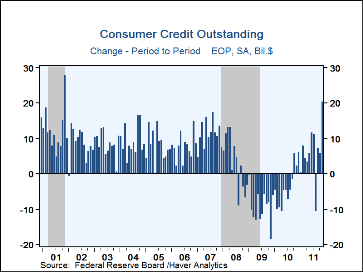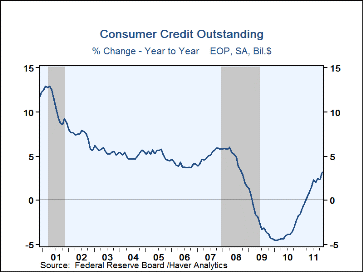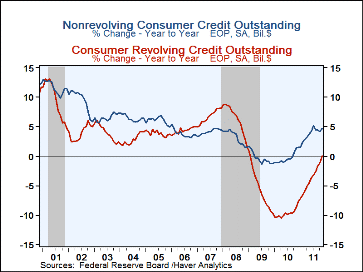 Global| Jan 10 2012
Global| Jan 10 2012U.S. Consumer Credit Outstanding Surges
by:Tom Moeller
|in:Economy in Brief
Summary
Consumers felt confident enough during November to significantly strengthen their usage of credit. The Federal Reserve reported that overall consumer credit surged $20.4B after a revised $6.0B gain during October, initially reported [...]
 Consumers felt confident enough during November to significantly
strengthen their usage of credit. The Federal Reserve reported that
overall consumer credit surged $20.4B after a revised $6.0B gain during
October, initially reported as $7.7B. A $7.0B increase had been expected
by Action Economics. This latest gain in credit was the strongest since
November, 2001. It raised usage 3.2% during the last twelve months
following the 1.7% decline during 2010.
Consumers felt confident enough during November to significantly
strengthen their usage of credit. The Federal Reserve reported that
overall consumer credit surged $20.4B after a revised $6.0B gain during
October, initially reported as $7.7B. A $7.0B increase had been expected
by Action Economics. This latest gain in credit was the strongest since
November, 2001. It raised usage 3.2% during the last twelve months
following the 1.7% decline during 2010.
Non-revolving credit, which accounts for nearly two-thirds of the total, surged $14.8B, the most since 2001. Loans by the Federal government rose by roughly one-third y/y. Loans by nonfinancial business increased 1.8% y/y while finance company lending gained 1.5% y/y. Loans by savings institutions inched up 0.8% y/y. To the downside, pools of securitized assets fell 12.1% y/y, commercial bank credit decreased 3.6% y/y and credit union lending was off 1.9% y/y.
Consumers revolving credit balances gained $5.6B during November leaving y/y usage unchanged. Credit issuance by savings institutions led the gain over the last year and rose 11.6%. Finance company credit rose 8.2% y/y while savings institution credit jumped 3.6% y/y. Credit union lending increased a moderate 3.6% y/y while nonfinancial business credit remained unchanged. Pools of securitized assets decreased 9.0% y/y and commercial bank credit fell 1.4% y/y.
During the last ten years, there has been a 53% correlation between the y/y change in credit outstanding and the change in personal consumption expenditures, although the correlation recently has weakened considerably. The credit figures are the major input to the Fed's quarterly Flow of Funds accounts for the household sector.
The consumer credit data are available in Haver's USECON database. The Action Economics figures are in the AS1REPNA database.
What Your Credit Report Says About You from the Federal Reserve Bank of Philadelphia is available here.
| Consumer Credit
Outstanding (M/M Chg, SAAR) |
Nov | Oct | Sep | Y/Y | 2010 | 2009 | 2008 |
|---|---|---|---|---|---|---|---|
| Total | $20.4B | $6.0B | $7.5B | 3.2% | -1.7% | -4.4% | 1.5% |
| Revolving | 5.6 | 0.7 | 0.4 | 0.0 | -7.5 | -9.6 | 1.7 |
| Non-revolving | 14.8 | 5.3 | 7.1 | 4.7 | 1.5 | -1.3 | 1.5 |
Tom Moeller
AuthorMore in Author Profile »Prior to joining Haver Analytics in 2000, Mr. Moeller worked as the Economist at Chancellor Capital Management from 1985 to 1999. There, he developed comprehensive economic forecasts and interpreted economic data for equity and fixed income portfolio managers. Also at Chancellor, Mr. Moeller worked as an equity analyst and was responsible for researching and rating companies in the economically sensitive automobile and housing industries for investment in Chancellor’s equity portfolio. Prior to joining Chancellor, Mr. Moeller was an Economist at Citibank from 1979 to 1984. He also analyzed pricing behavior in the metals industry for the Council on Wage and Price Stability in Washington, D.C. In 1999, Mr. Moeller received the award for most accurate forecast from the Forecasters' Club of New York. From 1990 to 1992 he was President of the New York Association for Business Economists. Mr. Moeller earned an M.B.A. in Finance from Fordham University, where he graduated in 1987. He holds a Bachelor of Arts in Economics from George Washington University.








